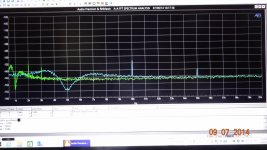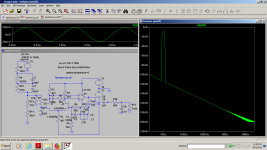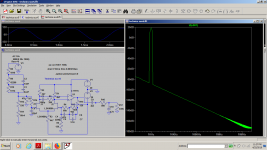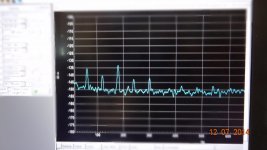Except the subtreshold region where most of the manufacturers actually are using the fets for the very low tempco and current consumption.Many commercial phono amplifiers with fet transistors operate high transconductance transistors at less than 0.1ma and less than 1v VDS .The transfer function (exponential) of the bipolar is worse than the fet with is (square law).
and capacitors are counteracting the exponential law of bipolars with their own exponential charging law!Bipolars require an input cap.
I dont see any significant difference between bipolar and fet for audio. Neither for Noise nor harmonic-wise.
Both can give ultra low noise and both can have only 2H and 3H dominant in any modern topology. Maybe for phono cart and direct coupled there is some advantage to use fets. Like high Zin and low current thru cart. But thats all I can think of.
What else?
THx-RNMarsh
All else being equal, an FET input preamplifier is less susceptible to RFI. Of course proper RF low-pass filters at inputs and outputs fix this for bipolars as well...
Howie
All else being equal, an FET input preamplifier is less susceptible to RFI. Of course proper RF low-pass filters at inputs and outputs fix this for bipolars as well...
Howie
Yeah, I've seen equipment with FET input op-amps still rectify GSM cell signal, probably best to filter everything.
So i just spent some minutes to sim the classical Technics su-v6 phono preamp, which should give monstruous h3 and very low h2...You have the asc file too if you can get better resolution than i could.
Attachments
Don't know how to say this in English: Diode demodulation of HF ?What else?
[edit] Oh, sorry, next page, hhoyt pointed this before me.
Last edited:
Hardly an unfixable problem though. Those nice Neutrik people even do EMC XLRs for when you have a very hostile RF environment.
Funny, I did the exact same, LM381AN, right to the datasheet, discovered what motor boating was, only heard of it in the National Semi Audio/Radio handbook. I switched to a Signetics NE5533 (dual), it sounded just sweet playing LP's, imo, better sounding than the Pioneer SX-950 discrete phono amp I had to compare with.I built an RIAA preamp with one of that nat semi devices in about 78 or possibly 79 but it oscillated and I was never able to find the problem given my level of knowledge at the time.
Don't know how to say this in English: Diode demodulation of HF ?
[edit] Oh, sorry, next page, hhoyt pointed this before me.
Yes, that's exactly how I'd say it in English, and of course with cell phones signals it's also VHF and UHF as well as HF from other sources.
I built an RIAA preamp with one of that nat semi devices in about 78 or possibly 79 but it
oscillated and I was never able to find the problem given my level of knowledge at the time.
That device was not compensated for unity gain, and had to be used at gains of x10
or more (without adding additional external compensation).
An RIAA network for 34dB midband gain would go below x10 gain at around 10kHz,
so instability would result.
Last edited:
All else being equal, an FET input preamplifier is less susceptible to RFI. Of course proper RF low-pass filters at inputs and outputs fix this for bipolars as well...
Howie
Maybe. though I have never seen it happen with my stuff. Anyway, still does not produce miles of harmonics. Only 2H and 3H primarily in anything I see from SOTA amps.
With FET so hard to match closely and their compl..... if the noise and distortion can be designed as low and doesnt show this high order harmonic structure, then, there is NO good reason to use them exclusively.
Just saying I never see anything above 3rd.

You dont need all fet .... So, what other reason could there be?
THx-RNMarsh
Attachments
Last edited:
Maybe. though I have never seen it happen with my stuff.
Yes, and it can still happen with FET inputs, even if they are more resistant. Not a great excuse to leave off an input RF filter.
I am not talking about input filters.
I am responding to JC reason to keep using FETs over bipolar.
Re their device harmonic structure produced.
-RNM
How do you delete the attached thumb nail?
I am responding to JC reason to keep using FETs over bipolar.
Re their device harmonic structure produced.
-RNM
How do you delete the attached thumb nail?
Last edited:
That device was not compensated for unity gain, and had to be used at gains of x10
or more (without adding additional external compensation).
An RIAA network for 34dB midband gain would go below x10 gain at around 10kHz,
so instability would result.
It was the circuit out of the book - so I think it was something else. Anyway, that preamp is long, long gone so I will never know.
Richard, I don't think you tried hard enough to distinguish between fets and bipolar transistors. I used bipolars primarily for about 5 years before finally using jfets in the same topologies, both preamp, and power amp. I always had more higher order, primarily 5th harmonic show up with bipolars. It is in the inherent transfer function of each device. Of course tubes are even more linear, and if they had a complement I would use them exclusively.
I recently ordered some electret condenser capsules. I got the part that includes two EMI filter capacitors inside the small 2mm thick aluminum case. So apparently some folks have trouble with FETs and EMI. In my experience they do have much greater immunity though.
With the cost of an on site service call around $1,000 it seems prudent to be safer.
With the cost of an on site service call around $1,000 it seems prudent to be safer.
Of course tubes are even more linear, and if they had a complement I would use them exclusively.
Good luck with the 0.4nV, back to transformers I guess?
Come on John, you would never even think of using the electron tube together with a positron tube if it were available. 😀Of course tubes are even more linear, and if they had a complement I would use them exclusively.
- Status
- Not open for further replies.
- Home
- Member Areas
- The Lounge
- John Curl's Blowtorch preamplifier part III


